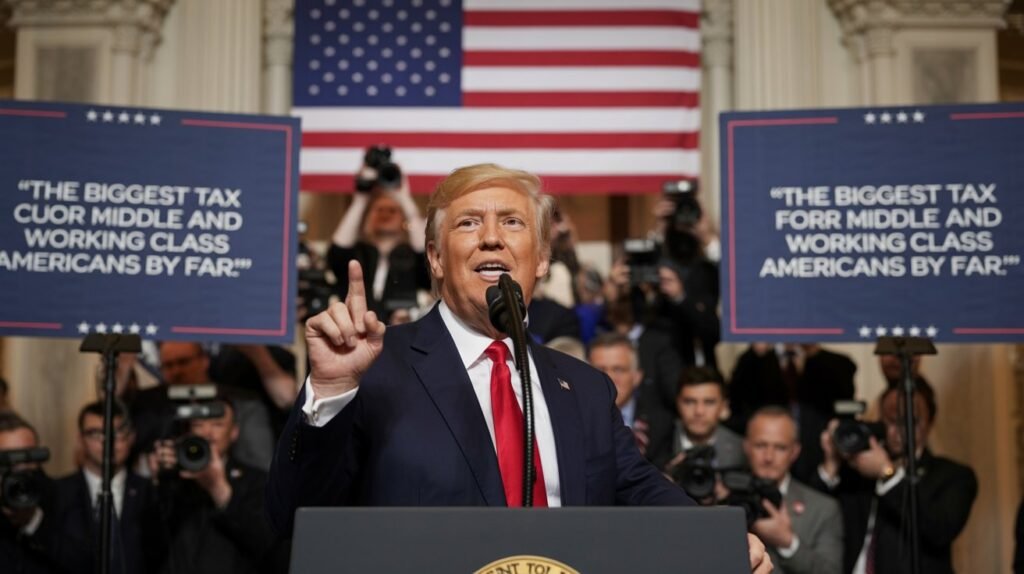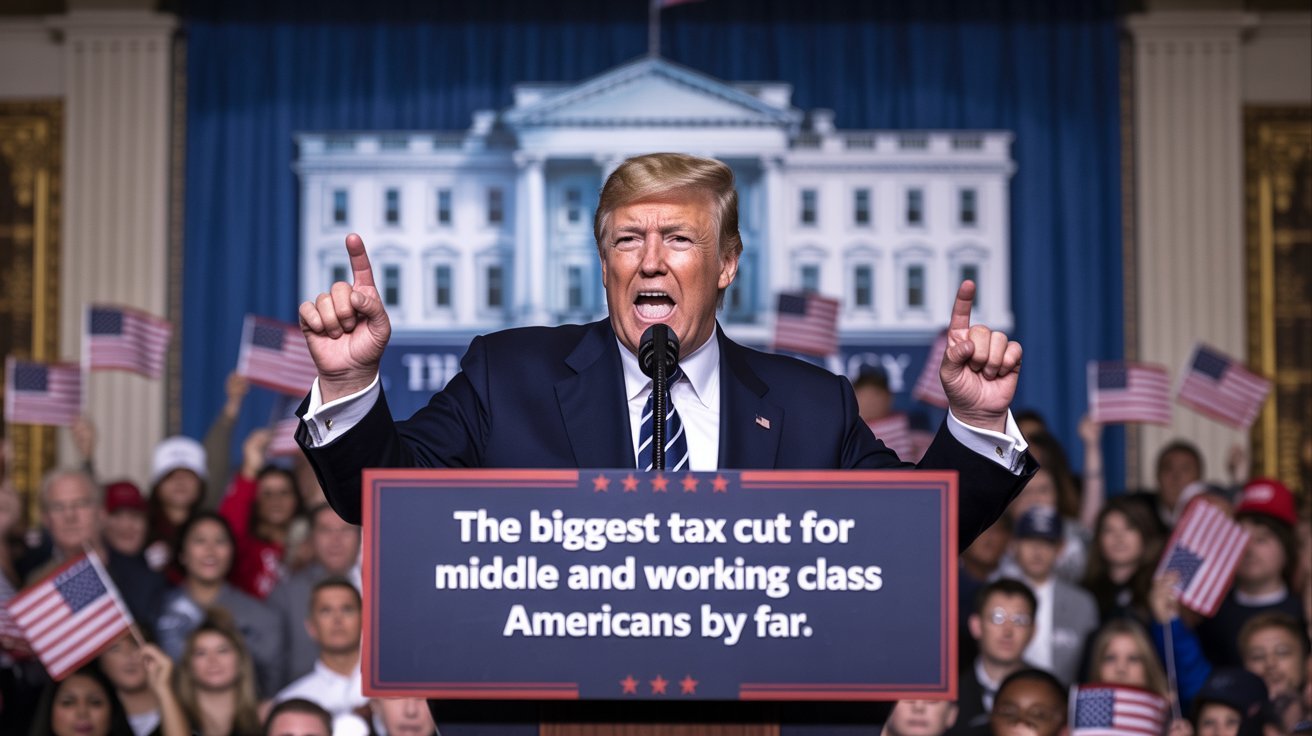Following his historic 2024 election victory, President Donald Trump has teased the Trump tax cuts 2025, billed as the “biggest ever” for middle and working-class Americans. With 312 electoral votes and a mandate driven by economic concerns, Trump aims to extend and expand the 2017 Tax Cuts and Jobs Act (TCJA) before its provisions expire in 2025. The Trump tax cuts 2025 promise lower income taxes, expanded credits, and small business relief, but critics warn of deficit risks and inflationary pressures.
Nexobytes breaks down the proposal, its implications, and what it means for you. Join our community for real-time economic updates!
Table of Contents
- What Are the Trump Tax Cuts 2025?
- The TCJA: A Foundation for 2025
- Economic Implications
- Political Challenges and Opportunities
- Crypto and Tax Policy: A Connection?
- A Critical Perspective
- What to Watch in 2025
- Stay Informed with Nexobytes
What Are the Trump Tax Cuts 2025?
The Trump tax cuts 2025, announced in early 2025, aim to deliver unprecedented relief to middle and working-class Americans. Key components include:
- Lower Income Tax Rates: Reducing rates for middle-income brackets to boost take-home pay.
- Expanded Tax Credits: Enhancing the Child Tax Credit and Earned Income Tax Credit (EITC) for families.
- Tax Exemptions: Eliminating taxes on tips, overtime pay, Social Security benefits, and auto loan interest for U.S.-made cars.
- Small Business Support: Permanently extending the TCJA’s 20% pass-through deduction, potentially creating 1 million jobs.
Trump’s plan, dubbed the “One, Big, Beautiful Bill,” also proposes closing loopholes like carried interest and ending tax breaks for billionaire sports team owners. These measures aim to stimulate spending and job growth.
The TCJA: A Foundation for 2025
The Trump tax cuts 2025 build on the 2017 TCJA, which lowered individual tax rates, doubled the standard deduction, and expanded the Child Tax Credit. Set to expire in December 2025, the TCJA’s extension is central to Trump’s plan. The Ways and Means Committee claims the TCJA benefited low- and middle-income families most, with the bottom 50% of earners seeing a 17.3% tax rate reduction.
However, critics like the Center on Budget and Policy Priorities argue the TCJA disproportionately favored the top 1%, who received $60,000 average tax cuts versus $500 for the bottom 60%. The Trump tax cuts 2025 aim to address these critiques by focusing on middle-class relief.
Economic Implications
The Trump tax cuts 2025 could reshape the U.S. economy. Proponents, citing the Council of Economic Advisers, claim extending the TCJA could boost short-run GDP by 3.3-3.8%, create 6 million jobs, and raise wages by $2,100-$3,300 per worker. Increased disposable income could drive consumer spending, fueling growth.
Critics warn of a $4.5 trillion revenue loss over 2025-2034, increasing deficits by $5.1 trillion before economic effects. Tariffs proposed by Trump, such as 10-20% on imports, could offset some losses but raise consumer prices, costing middle-income households ~$1,200 annually. Posts on X reflect concerns about inflation from unfunded cuts. For related economic trends, see our Bitcoin Summer 2025 Post.
Crypto and Tax Policy: A Connection?
The Trump tax cuts 2025 could intersect with crypto markets. Lower taxes might increase disposable income, driving investment in digital assets like Bitcoin, currently at ~$84,536. Additionally, Trump’s pro-crypto stance, including potential blockchain incentives, could align with tax policies to boost fintech innovation. For more, see our OCC Crypto Banking Post and Stripe Stablecoin Accounts Post.
Political Challenges and Opportunities
The Trump tax cuts 2025 face a divided Congress. Republicans, controlling the House and Senate, aim to use budget reconciliation to pass the “One, Big, Beautiful Bill” with a simple majority. Democrats, like Rep. Richard Neal, call it a “reverse Robin Hood scam,” arguing it favors the rich. Bipartisan support may hinge on compromises, like preserving credits for low-income households.
Trump’s strategic timing leverages the TCJA’s expiration to rally working-class voters, as seen in X posts praising no taxes on tips and overtime. Public sentiment will shape debates, with Nexobytes tracking legislative progress.
A Critical Perspective
While the Trump tax cuts 2025 promise relief, the establishment narrative—pushed by both parties—requires scrutiny. Republicans claim universal benefits, yet Tax Policy Center data shows the top 1% could gain 23.5% of benefits, versus 1.3% for the middle 20%. Democrats’ “tax the rich” rhetoric ignores their own support for corporate loopholes. The real risk is deficit-funded cuts paired with tariffs, which could inflate prices without addressing structural issues like wage stagnation.
What to Watch in 2025
The Trump tax cuts 2025 are not yet law. Key developments to monitor include:
- Legislative Drafting: Details of the “One, Big, Beautiful Bill” expected by summer 2025.
- Congressional Votes: Reconciliation debates in fall 2025 will determine passage.
- Economic Data: Inflation and deficit impacts as tariffs and cuts roll out.
- Market Reactions: Stock and crypto market responses to policy certainty.
Conclusion
The Trump tax cuts 2025 represent a bold vision to alleviate financial burdens for middle and working-class Americans, building on the TCJA’s legacy with promises of lower taxes, expanded credits, and small business support. If enacted, these cuts could boost consumer spending and job creation, potentially reshaping the U.S. economy. However, the risks of ballooning deficits, inflationary tariffs, and skewed benefits toward the wealthy demand careful scrutiny. Both Republican and Democratic narratives oversimplify the proposal’s impacts, and the real test lies in Congress’s ability to balance fiscal responsibility with economic relief.

For individuals and businesses, the Trump tax cuts 2025 could offer opportunities to save and invest, including in crypto markets buoyed by increased disposable income. Yet, uncertainties around inflation and tariffs underscore the need for strategic financial planning. As legislative debates unfold, Nexobytes remains committed to delivering clear, data-driven insights to help you navigate this transformative economic shift. Stay engaged with us to understand how these policies could shape your financial future and the broader crypto landscape.
At Nexobytes, we’ll continue to follow developments closely, breaking down what it means for individuals, businesses, and the broader economy.
Stay tuned — the tax landscape in 2025 is about to shift in a big way.


